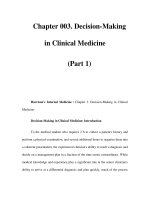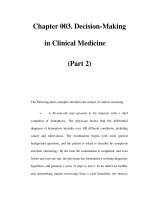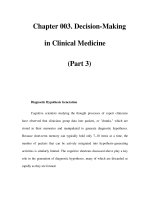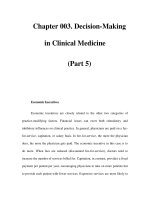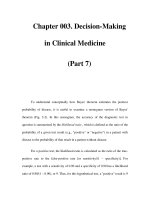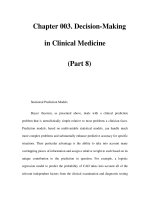Chapter 003. Decision-Making in Clinical Medicine (Part 8) docx
Bạn đang xem bản rút gọn của tài liệu. Xem và tải ngay bản đầy đủ của tài liệu tại đây (13.63 KB, 5 trang )
Chapter 003. Decision-Making
in Clinical Medicine
(Part 8)
Statistical Prediction Models
Bayes' theorem, as presented above, deals with a clinical prediction
problem that is unrealistically simple relative to most problems a clinician faces.
Prediction models, based on multivariable statistical models, can handle much
more complex problems and substantially enhance predictive accuracy for specific
situations. Their particular advantage is the ability to take into account many
overlapping pieces of information and assign a relative weight to each based on its
unique contribution to the prediction in question. For example, a logistic
regression model to predict the probability of CAD takes into account all of the
relevant independent factors from the clinical examination and diagnostic testing
instead of the small handful of data that clinicians can manage in their heads or
with Bayes' theorem. However, despite this strength, the models are too complex
computationally to use without a calculator or computer (although this limit may
be overcome once medicine is practiced from a fully computerized platform).
To date, only a handful of prediction models have been properly validated.
The importance of independent validation in a population separate from the one
used to develop the model cannot be overstated. An unvalidated prediction model
should be viewed with the same skepticism appropriate for a new drug or medical
device that has not been through rigorous clinical trial testing.
When statistical models have been compared directly with expert clinicians,
they have been found to be more consistent, as would be expected, but not
significantly more accurate. Their biggest promise, then, would seem to be to
make less-experienced clinicians more accurate predictors of outcome.
Decision Support Tools
Decision Support Systems
Over the past 35 years, many attempts have been made to develop
computer systems to help clinicians make decisions and manage patients.
Conceptually, computers offer a very attractive way to handle the vast information
load that today's physicians face. The computer can help by making accurate
predictions of outcome, simulating the whole decision process, or providing
algorithmic guidance. Computer-based predictions using Bayesian or statistical
regression models inform a clinical decision but do not actually reach a
"conclusion" or "recommendation." Artificial intelligence systems attempt to
simulate or replace human reasoning with a computer-based analogue. To date,
such approaches have achieved only limited success. Reminder or protocol-
directed systems do not make predictions but use existing algorithms, such as
practice guidelines, to guide clinical practice. In general, however, decision
support systems have shown little impact on practice. Reminder systems, although
not yet in widespread use, have shown the most promise, particularly in correcting
drug dosing and in promoting adherence to guidelines. The full impact of these
approaches will only be evaluable when computers are fully integrated into
medical practice.
Decision Analysis
Compared with the methods discussed above, decision analysis represents a
completely different approach to decision support. Its principal application is in
decision problems that are complex and involve a substantial risk, a high degree of
uncertainty in some key area, or an idiosyncratic feature that does not "fit" the
available evidence. Five general steps are involved. First, the decision problem
must be clearly defined. Second, the elements of the decision must be made
explicit. This involves specifying the alternatives being considered, their relevant
outcomes, the probabilities attached to each outcome, and the relative desirability
(called "utility") of each outcome. Cost can also be assigned to each branch of the
decision tree, allowing calculation of cost effectiveness. Typically, the data to
populate a decision model are derived from the literature, from unpublished
sources, from expert opinion and from other secondary sources. Third, the
decision model must be "evaluated" to determine the net long-term health benefits
and costs of each strategy being considered. Fourth, the incremental health
benefits and costs of the more effective strategies must be calculated. Finally,
extensive sensitivity analyses must be used to examine the effects on the results of
varying the starting assumptions through plausible alternative values.
An example decision tree created to evaluate strategies for screening for
human immunodeficiency virus (HIV) infection is shown in Fig. 3-3. Up to 20,000
new cases of HIV infection are believed to be caused each year in the United
States by infected individuals who are unaware of their illness. In addition, about
40% of HIV-positive patients progress to AIDS within a year of their diagnosis.
Early identification offers the opportunity both to prevent progression to AIDS
through use of serial CD4 counts and measurements of viral load linked to
selective use of combination antiretroviral therapy and to encourage reduction of
risky sexual behavior.
The Centers for Disease Control and Prevention (CDC) proposed in 2003
that routine HIV testing should be a part of standard medical care. In a decision-
model exploration of this proposed strategy compared with usual care, assuming a
1% prevalence of unidentified HIV infection in the population, routine screening
of a cohort of 43-year-old men and women increased life expectancy by 5.5 days
and cost $194 per subject screened. The cost-effectiveness ratio for screening
relative to usual care was $15,078 per quality-adjusted life year. Results were
sensitive to assumptions about the effectiveness of behavior modification on
subsequent sexual behavior, the benefits of early therapy of HIV infection and the
prevalence and incidence of HIV infection in the population targeted. This model,
which required over 75 separate data points, provides novel insights into a clinical
management problem that has not been subjected to a randomized clinical trial.
The process of building and evaluating decision models is generally too
complex for use in real-time clinical management. The potential for this tool
therefore lies in the development of a set of published models addressing a
particular decision or policy area that can serve to highlight key pressure points in
the problem. Although many published models tend to focus excessively on
providing an "answer," their better role is to enhance understanding of the most
important questions that deserve particular attention in clinical decision-making

